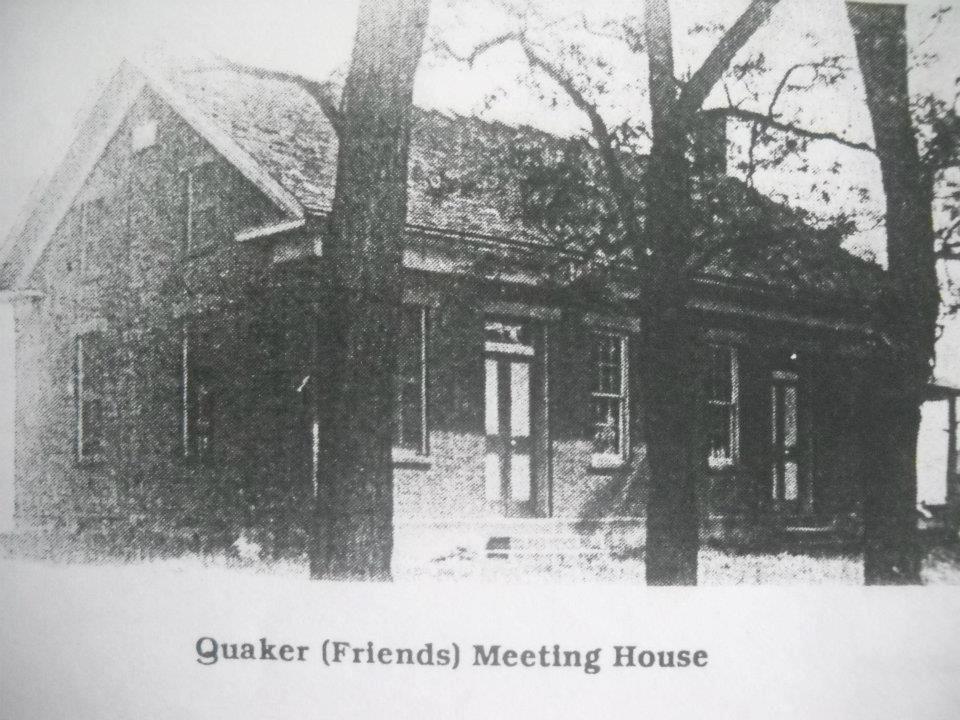by Taylor C. Woodward

AUGUSTA FRIENDS OR QUAKER MEETING HOUSE

The
Augusta Society of Friends was a branch of the Sandy Spring Society
of Friends. Sandy Spring Meeting House was located about one
mile west of Hanoverton, in Columbiana County, and was one of the
oldest meeting houses in the vicinity. It was built by a group
of Friends,
Stephen McBride, initiating the move to erect a log meeting
house and school house in 1807. Later in 1827, to accommodate
the growing congregation, a brick meeting house was built, which was
used for more than half a century.
Stephen McBride later came to what is now Augusta Township,
Carroll County, having received a patent deed in 1820, from the U.S.
Land Office at Steubenville - James Monroe, President, for the S.E.
1/4 of Sec. 2, Township 15, Range 5. (The writer of this
having this deed in his possession.)
A burying ground adjacent to the meeting house, above mentioned, is
the final resting place of three soldiers of the American
Revolution:
Stephen McBride,
Andrew Milbourn, and William Skelton, all familiar names in the
early history of Augusta Township.
|
|
The same committee also received a deed in trust, from David Haldeman and Ann his wife, Oct. 12, 1825, for one acre of land, adjoining the one acre they had received in 1818, on the north side. On the latter, a school house had been built in 1810, and was called the Augusta "Friends" School House. This is the earliest school house in the vicinity, of which a record has been found. The schoolmaster was Nathan Pim, who passed away in 1816 and was laid to rest near the school house, and is said to be the first person buried in the "Friends" or Quaker Cemetery.
Oct. 27, 1840, the above named committee transferred both lots to the new trustees appointed: Taber Coulson, Mahlon Hole, James Chambers, and David Haldeman. A meeting was held by the trustees and others June 13, 1840 at which time and place, it was decided to build a log meeting house, with donation labor, on the lot bought for that purpose. Work was commenced June 18, 1840, and continued as time permitted, until it was completed in the fall of 1841.
Meetings were held in this building by the Friends or Quakers, for many years, where silent worship was held. To many, the pioneer Quaker's way of worship was unusual. Their meeting begins, not with a hymn or any formal opening whatsoever, but by those who have met to worship God, settling themselves in silence to self examination, meditation and secret prayer, the men usually on one side of the room and the women on the other. The stillness thus begun, may continue for a longer or a shorter period, possibly during the whole meeting, for it may please the Lord, or leaders that no word be spoken.
Often however, some are given messages by Him to deliver. When any are thus led to speak, they rise and express their message, from whatever part of the building they may be in, or if anyone feels called upon to offer vocal prayer, he or she kneels, while the congregation rises and remains standing till the prayer is ended. When the meeting for worship has continued as long as those, sitting at the head of it think profitable, they turn to each other and shake hands, which act, while expressing the renewed bond of Christian fellowship, marks the conclusion of the meeting.
No musical instruments were used in their meetings, in the old meeting house. One of the early customs of the Friends, was burying the Friends in rows instead of family lots, and some using sandstone for a marker, with only their initials and date cut on it.
Having held meetings in the old Meeting House for thirty years and more, the congregation having continued to increase as time passed by, and many changes having taken place, in 1876, it was decided to build a new and larger brick meeting house, which was completed and ready for occupancy Feb. 20, 1877.
This Meeting House is remembered by many of the present generation. The building being heated by a large round heating stove on each side of the room, and lighted by a large chandelier or ring of oil lamps, hung from the ceiling on each side of the room, also an oil reflector lamp on the wall, back of the minister, on each side. The back row seats being raised one step higher than the rest.
Many of the regular members had stalls built with a roof over them, for the protection of their horses from the weather, while at the meetings. These meetings were well attended around the year 1900, for many years before and after, and the house was filled to overflowing many times. Meetings have been held outdoors in a tent, when the meeting house would not hold the crowds, which attended special meetings, which were held at times. One of the many changes made, was the use of the organ, in their meetings. Protracted meetings were held at times, with special speakers. Regular ministers were had for a period of time.
After an extended period of time, as many of the old Friends had passed away, and some had moved away, and not enough members remaining to keep up the Meeting House, and as the roof was in need of repairs, they decided rather than take a chance of it being desecrated by vandals, they would have the building taken down, which they did about 1946.
The cemetery marks the location, which is partly in Carroll, but mostly in Columbiana County, and is well taken care of by the Trustees of West Township, Columbiana County.

